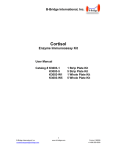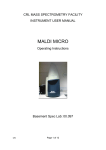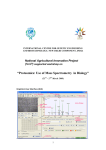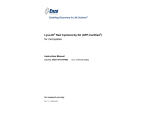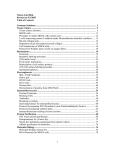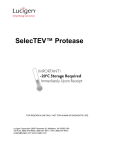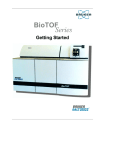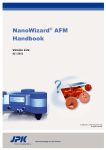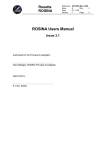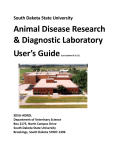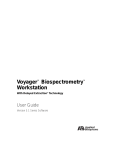Download 3 - GE Healthcare Life Sciences
Transcript
guide book proteomics Method Handbook gb 18-1144-03 All goods and services are sold subject to the terms and conditions of sale of the company within the Amersham Biosciences group which supplies them. A copy of these terms and conditions is available on request. Ettan is a trademark of Amersham Biotech Limited. Amersham is a trademark of Nycomed Amersham plc. ZipTip is a trademark of Millipore Inc. ©Amersham Biosciences AB 2000 -All rights reserved Office Addresses Amersham Biosciences AB SE-751 84 Uppsala Sweden Amersham Biosciencse UK Limited Amersham Place Little Chalfont Buckinghamshire England HP7 9NA Amersham Biosciences Inc. 800 Centennial Avenue P.O. Box 1327 Piscataway N.J. 08855-1327 USA Amersham Biosciences Europe GmbH Munzinger Strasse 9 D-79111 Freiburg Germany Amersham Biosciences KK Sanken Building 3-25-1 Hyakunincho, Shinjuku-ku Tokyo Japan Contents 1 Introduction 1.1 Symbols and common abbreviations ............................................ 8 2 An introduction to MALDI-ToF MS 2.1 Principles of MALDI-ToF mass spectrometry .............................. 10 2.2 Applications for MALDI-ToF mass spectrometry ......................... 12 3 Sample Preparation 3.1 Removal of contaminants ........................................................... 17 3.2 Sample Extraction from Electrophoresis Gels .............................. 19 3.3 Choosing the Matrix ................................................................... 20 3.4 Preparing Solutions for Crystallization ......................................... 22 3.4.1 Dissolving the protein or peptide .......................................... 23 3.4.2 Dissolving the matrix ............................................................ 23 3.5 Applying Sample to the Slide Surface ......................................... 24 3.5.1 Dried Droplet Method........................................................... 25 3.5.2 Thin Layer Method............................................................... 26 3.5.3 Slow Crystallization Method .................................................. 27 3.5.4 Seeded Microcrystalline Film Method ................................... 28 3.6 Preparation for Specific Applications .......................................... 29 3.6.1 Identification by peptide mass fingerprinting......................... 30 3.6.2 Protein characterization I ..................................................... 32 3.6.3 Protein characterization II .................................................... 33 3.6.4 Identification of protein phosphorylation sites ....................... 36 Ettan MALDI-ToF Method Handbook 18-1144-03 Edition AA v 1 Introduction 1 Introduction Ettan MALDI-ToF combines the protein knowledge of Amersham Biosciences that of experts in protein identification (Proteometrics LLC) and mass spectrometry (Scientific Analysis Instruments Ltd.) to offer a MALDI-ToF mass spectrometer for fast, reliable protein identification. Ettan MALDI-ToF is particularly suited for high throughput work requiring rapid identification and high sensitivity detection, as in proteomic studies. In order to obtain an accurate mass analysis and so achieve a reliable identification, the correct sample extraction and preparation procedures are as crucial as the interpretation and evaluation of mass spectra. The purpose of this handbook is to familiarize the reader with the key practical aspects that should be considered for successful protein identification. Specific protocols are supplied for applications performed on Ettan MALDI-ToF systems, together with general background information that may be of use to those new to MALDI-ToF mass spectrometry. Intensity File:OneR2-16 Spectrum:1 Laser:0 Position:16:32 Date:Wed Feb 16 11:56:32 2000 Shots:250 1500 1400 1300 1200 1100 1000 900 800 700 600 500 400 300 200 100 0 800 1 000 1 200 1 400 1 600 1 800 Mass (m/z) 2 000 2 200 2 400 2 600 Fig 1-1. The Ettan MALDI-ToF system, Single high resolution result and ProFound identification report Ettan MALDI-ToF Method Handbook 18-1144-03 Edition AA 7 1 Introduction 1.1 Symbols and common abbreviations general advice that can improve procedures or recommendations for action under specific situations warning, when special care should be taken in a procedure MS: mass spectrometry MALDI-ToF: matrix-assisted laser desorption and ionization-time-offlight 4-HCCA: α-cyano-4-hydroxycinnaminic acid DHB: 2,5-dihydroxybenzoic acid, also known as gentisic acid 8 Ettan MALDI-ToF Method Handbook 18-1144-03 Edition AA 2 An introduction to MALDI-ToF MS 2 An introduction to MALDI-ToF MS MALDI-ToF mass spectrometry has become one of the most important tools for the identification of proteins and peptides, and is particularly important in proteomic studies where it plays a key role in the identification of potential target proteins, as illustrated in Fig. 2-1. This chapter gives an overview of the key steps in mass analysis by MALDIToF MS. Normal cell Transformed cell Extract protein fraction of interest 2-D PAGE Key Abundance up Abundance down Differential display Excise spots of interest Trypsin digest and MS analysis Peptide mapping by mass spectrometry Protein sequence database searched ? ? ? ? ? ? ? ? ? ? ? ? ? ? ? ? ? ? ? ? ? ? ? ? ? ? ? ? ? ? ? ? ? ? ? ? ? ? ? ? ? ? ? ? Identified proteins Abundance up Abundance down (?) Unidentified proteins Data evaluated and potential protein markers and drug targets identified Biological experiments to elucidate function Target proteins identified Fig 2-1. The role of mass spectrometry in proteomic studies Ettan MALDI-ToF Method Handbook 18-1144-03 Edition AA 9 2 An introduction to MALDI-ToF MS 2.1 Principles of MALDI-ToF mass spectrometry A mass analysis begins by careful sample preparation. Most frequently the source material originates from an SDS electrophoresis gel and samples must be extracted and cleaned before preparation for the MS analysis. The cleaned protein or peptide is mixed with a matrix. The matrix ensures that the surroundings of a protein or peptide are such that, when subjected to the intense light pulse from a laser, the molecules become ionized. As the matrix crystallizes on the surface of the sample slide (Fig. 2-2), the proteins or peptides become incorporated into the crystals. The sample slide is used to carry the samples into the flight tube of the mass spectrometer. Fig 2-2. Sample slide from Ettan MALDI-ToF Fig. 2-3 illustrates the process that follows as soon as the samples are loaded into the mass spectrometer. It is at this stage that MatrixAssisted Laser Desorption and Ionization (MALDI) begins. Laser pulse Sample + m + + Ion source +V v + + + + + Detector + + + + L (length of drift tube) Fig 2-3. Matrix Assisted Laser Desorption, Ionization and Detection The sample slide and laser are together referred to as the ion source used for sample irradiation. 10 Ettan MALDI-ToF Method Handbook 18-1144-03 Edition AA 2 An introduction to MALDI-ToF MS Short-duration (nanosecond) pulses of laser light are directed at the crystals. The energy absorbed causes a portion of the crystal’s surface to be volatilized and ionized, creating an ion cloud. The application of an electrostatic field prompts the ions to move through the vacuum of the flight tube towards the detector. If the ion cloud contains protein or peptide molecules, they will also move. The energy deposited by the laser can be adjusted to optimize conditions for this ion ablation step. The gas-phase ions are accelerated to a fixed energy (i.e. a common kinetic energy) and, after passing through the flight tube, they impact onto an ion detector. By measuring the time between the application of the accelerating electrostatic field and the arrival of the ion at the detector (∆ tm), the mass of the ion can be determined by Time of Flight (ToF) mass analysis: m = 2qV∆t2m/l2 m = ion mass q = ion charge V = potential through which ion is accelerated l = length of flight tube The complete derivation of this equation is given in the Ettan MALDIToF Instrument Handbook. In simple terms, when all ions are equally charged, a lighter mass will travel faster than a heavier mass. As each ion reaches the detector, a peak is generated, creating a mass spectrum i.e. a plot of signal intensity generated against time, as shown in Fig. 2-4. The mass-to-charge ratio (m/z) that corresponds to a particular peak is calculated using simple equations and the time-to-intensity data is converted into an m/z-tointensity histogram. Intensity Medium mass + + + Low mass + + + + + + High mass + + + m/z Fig 2-4. Example of a mass spectrum Ettan MALDI-ToF Method Handbook 18-1144-03 Edition AA 11 2 An introduction to MALDI-ToF MS Each peak in a mass spectrum is now assigned a specific mass. By recording time-of-flight mass spectra as intensity versus time-of-flight tables, the mass-to-charge (m/z) data is calculated as follows: (m/z)1/2 = at + b Although the constants a and b are related to the geometry of the ion source and mass analyser, they are most commonly determined by the simple and accurate method of selecting two peaks of known m and z and deriving the constants from their measured flight times. With the constants a and b established, the values can be applied to calibrate other spectra produced under the same experimental conditions. Further details on calibration methods are outlined in the Ettan MALDI-ToF User Manual. It should be noted that a two point calibration is generally satisfactory when working with peptides. However, in some instruments, this calibration may not be completely linear so that higher terms will be required in the equation. Under these circumstances an accurate calibration, over a wider mass range, should be obtained using more than two points (multi-point calibration). Depending upon the matrix solution, as well as other specific sample conditions, the MALDI-ToF spectrum may contain single- or doublecharged species. Evaluation software is used to identify the peaks that have originated from a single mass with different charges. Ettan MALDI-ToF uses the most powerful data analysis software available for the identification process. The list of masses (for example, a peptide mass fingerprint generated from mass analysis of a proteolytic digest) is compared with real or theoretically generated data stored in databases, until a match is found or a new protein discovered. 2.2 Applications for MALDI-ToF mass spectrometry The diagram shown in Fig. 2-3 illustrates a MALDI-ToF mass spectrometer used in linear detector mode: ions, under the influence of an electric field, travel in a straight line towards the detector and lighter masses arrive before the heavier masses. In the simplest terms, the mass relates to the time of flight and a mass spectrum shows the separation between the masses according to their flight time to reach the detector. For mass analysis of full length proteins, it is usually sufficient to use a MALDI-Tof instrument in linear detection mode. 12 Ettan MALDI-ToF Method Handbook 18-1144-03 Edition AA 2 An introduction to MALDI-ToF MS However, for mass analysis of a peptide mixture (as required for protein identification by peptide mass fingerprinting), a MALDI-ToF instrument is used in reflectron mode. The masses in a peptide mixture are smaller and likely to be distributed over a narrow range of mass values. The ions generated must be made to travel longer distances in order to enhance the differences in flight times between these ions. The reflectron acts as an ion mirror which corrects for variations in energy of ions of equivalent mass/charge (m/z) ratio. The reflectron increases the flight path of the ions, by applying a stepwise increase in voltage across the ion flight path, as illustrated in Fig. 2-5. A longer flight path results in a greater separation between the different masses, seen as higher resolution in the mass spectrum. The overall result is a better time-focus at the detector and high resolution mass spectra with excellent mass accuracy. Peptides can be studied further by creating conditions under which the peptides themselves are broken apart within the mass spectrometer and the resulting fragments are analysed. This analysis not only provides more information about the original protein, but, if initial identification has been unsuccessful, it can also be used for database comparisons. To perform fragmentation analysis, a MALDI-ToF instrument is used in reflectron mode, but now the peptides are ionized at an increased laser power, thus giving them more internal energy. Bonds are broken apart, giving rise to a product ion and a neutral fragment. This phenomenon is known as post source decay (PSD). The linear section of the Ettan MALDI-ToF is used to separate ions of different m/z ratio and bring them into time focus at the entrance to the reflectron. A timed ion gate selects a precursor mass for PSD analysis in the reflectron. In PSD experiments the energy of ionization is increased by the application of high laser power, this generates ions of higher energy and promotes fragmentation. When fragmentation occurs the fragment ions continue to travel with the same velocity as the precursor ion, but have lower energy. Thus, fragments from a precursor ion and the intact precursor ion, arrive at the timed ion gate simultaneously. The flight times of the fragment ions in the reflectron vary by virtue of their differing m/z ratio and a fragment ion spectrum is obtained. In this way the fragments of a single specific peptide can be detected and analysed. Ettan MALDI-ToF contains a unique reflectron, based on patented z2 technology, that applies an increasing voltage, non-linearly, to create a perfect quadratic field, as shown in Fig. 2-5. Ettan MALDI-ToF Method Handbook 18-1144-03 Edition AA 13 2 An introduction to MALDI-ToF MS Detector, linear mode Reflectron voltage Z Timed ion gate 2 Detector, reflectron mode DIC laitnetop Laser Accelerating voltage Sample slide Fig 2-5. Quadratic-field reflectron of Ettan MALDI-ToF. This unique quadratic-field reflectron provides time focusing of all ions irrespective of energy over the entire range of m/z. Hence a complete fragment ion mass spectrum is obtained under the same experimental conditions with each pulse of the laser, as shown in Fig. 2-6. Experimental conditions Unmodified Angiotensin III RVYIHPI Detection mode: PSD Intensity Ion gate mass: 897 10000 x 10.00 Ion polarity: Positive 9000 229.15 Y2 Acceleration potential: 20 kV 8000 Mass range: Low 228.18 A2 Pulsed extraction: On 7000 Focus mass: 897 H-27 391.25 A3 504.33 A4 419.24 B3 6000 50 shots per spectrum 897.53 Y7 642.36 Y5 366.21 Y3 641.39 A5 532.32 B4 669.38 B5 B4-17 B5-17 879.52 B7 5000 Manual tuning B3-17 4000 C6 ? 3000 A2-17 A4-17 A5-17 2000 1000 0 0 200 400 Mass (m/z) 600 800 Fig 2-6. Example of a MS spectrum of ile7Angiotensin III, using PSD. 14 Ettan MALDI-ToF Method Handbook 18-1144-03 Edition AA 2 An introduction to MALDI-ToF MS In all Ettan MALDI-ToF modes, a low mass rejection gate eliminates interference from low molecular weight compounds, such as those generated by components of the matrix, to further improve the detection and resolution of peaks in the mass spectrum. Ettan MALDIToF is designed to switch easily between linear and reflectron mode to give the performance required for a specific application. Ettan MALDI-ToF Method Handbook 18-1144-03 Edition AA 15 3 Sample Preparation 3 Sample Preparation 3.1 Removal of contaminants To achieve the accurate mass analysis needed for reliable identification, the correct sample preparation is crucial. The protein or peptide should be transferred intact into the flight tube of the mass spectrometer. The presence of contaminants from previous techniques, the solutions used to dissolve the sample and the type of matrix used to contain the sample on the slide surface may all affect this process. The MALDI-ToF technique is quite tolerant of certain contaminants (Table 3-1 ). However, to achieve a high quality mass analysis, it is advisable to remove as many contaminants as possible or, at least, reduce them to acceptable levels. When working with low amounts of material (e.g. an extract from a weak 2D spot), the removal of salt will improve the signal to noise ratio. Potential contaminant Tolerated levels Phosphate buffers < 20 mM Tris buffer < 50 mM Detergents < 0.1% Alkali metal salts <1M Guanidine <1M Ammonium bicarbonate < 30 mM Glycerol To be avoided SDS To be avoided Sodium azide To be avoided Table 3-1. Tolerance levels for contaminants in a MALDI-ToF analysis. A range of solvents and chemicals are frequently used for protein and peptide dissolution. Although necessary, they provide a source of unwanted contaminants during sample preparation and mass analysis. The solvent chosen to dissolve the sample must be compatible with the matrix. Ettan MALDI-ToF Method Handbook 18-1144-03 Edition AA 17 3 Sample Preparation Table 3-2 shows the most commonly used solvents and chemicals, together with the actions required to avoid any interference in a subsequent mass analysis. Methods for the application of sample to the slide surface are also referred to in this table and are described in detail further on in this chapter. Potential contaminants Sodium azide Comments MUST be removed. Suppresses ion formation in the mass spectrometer. Formic acid: 2-propanol:water Recommended for hydrophobic peptides (1:2:3 v/v) and proteins. High concentration formic acid Avoid long term exposure if mass accuracy is essential (forms formyl derivatives of N-terminal amino acids). High concentration salts, buffers Remove if possible. May interfere with or urea crystallization. If present use thin layer method. Glycerol MUST remove, concentrations > 1% interfere with crystallization. Strong ionic detergents MUST be removed. Prevent incorporation of samples into growing crystals. Non-ionic detergents e.g. Triton X May interfere with crystallization, avoid or N-octylglucoside if possible. Effects vary according to specific detergent, e.g. N-octylglcoside may have a beneficial effect at low concentrations. If present, use slow crystallization method (N.B. this requires some practice). Table 3-2. Potential contaminants Low signals (calibration peptides cannot be seen) and poor resolution (noisy background spectrum) indicate that the sample should be cleaned. Run the first analysis on only half of the sample. This will allow a second analysis on a cleaned up sample if required. Reverse phase chromatography (RPC) is frequently used to remove salts and other low molecular weight substances. Peptides are bound to an RPC column containing 10-20 µm C18 medium. This process desalts and concentrates the sample, since the peptides bind in the presence of 0.1%TFA and are eluted in a small volume (1-4 µl) of 50% acetonitrile, 0.1%TFA. Columns are often handmade, by packing the RPC medium into microtips, or obtained as commercial products, such as ZipTip. 18 Ettan MALDI-ToF Method Handbook 18-1144-03 Edition AA 3 Sample Preparation 3.2 Sample Extraction from Electrophoresis Gels Samples are often extracted from an electrophoresis gel before being prepared for mass analysis. For example, in proteomic studies, potential target proteins are selected during expression analysis, a process that compares protein profiles between normal and altered tissue. Two dimensional electrophoresis separations generate patterns of protein spots that can be visualized and compared by image analysis. The proteins of interest are then cut from the gel. The gel pieces are destained, subjected to an in-gel digest and the peptides extracted and cleaned, as illustrated in Fig. 3-1. Extract peptides, desalt and analyze by MALDI-TOF MS Transfer gel piece to microtube Destain Dehydrate Rehydrate and digest Incubate Fig 3-1. Preparation of protein spots for MS identification Coomassie Blue is recommended for visualization of protein spots. The dye binds stoichiometrically to proteins, a significant advantage when determining relative amounts of protein. Staining is simple and the Coomassie Blue does not usually interfere with subsequent mass analysis. Coomassie Blue R-350 is the most sensitive form of the dye, available from Amersham Biosciences (code no: 17-0518-01). The highest quality HPLC grade water should be used for every step after the sample has been excised from the gel. Although silver staining is 100 times more sensitive than Coomassie Blue, it may interfere with mass analysis. However, a recent publication outlines a method that avoids this problem by using a modified silver staining protocol from which glutaraldehyde is eliminated (Gharahdaghi et al., Electrophoresis, 20, p601-605, 1999). Using the modified protocol, while improving mass analysis results, may reduce the sensitivity of the silver staining. Ettan MALDI-ToF Method Handbook 18-1144-03 Edition AA 19 3 Sample Preparation Detergents and excess salts are usually eliminated during normal staining procedures. Strong ionic detergents, such as sodium dodecyl sulphate (SDS), must be completely removed as they will interfere with crystallization and so disrupt the mass analysis. 3.3 Choosing the Matrix The surroundings of a protein or peptide should ensure that, when subjected to the intense light pulse of a laser, the molecule is transferred, in an ionized state, into the flight tube. To achieve this effect the sample is incorporated into crystals of a second material- the matrix. The sample-containing crystal absorbs the light pulse and the absorbed energy causes desorption of material from the crystal’s surface, creating an ion cloud. If the desorbed material contains protein or peptide molecules, they will also enter the flight tube. It should be noted that, in earlier MALDI-ToF instruments, matrix compounds were seen to produce adduct peaks. These are satellite signals resulting from the chemical breakdown of the matrix into more reactive species that bind to the protein or peptide. They have slightly higher mass than the analyte molecule peaks. However, this phenomenon occurred when very high laser energies were required to compensate for lack of sensitivity. Adduct peaks are rarely seen in today’s, more sensitive, MALDI-ToF instruments. If salts are present in the sample then satellite peaks, containing Na+ or K+ that replace protons as the charge donor, may be seen. Similar satellite peaks will also occur when using poor quality matrix substances. 20 Ettan MALDI-ToF Method Handbook 18-1144-03 Edition AA 3 Sample Preparation Table 3-3 shows the most commonly used matrix compounds and indicates the ionization states. Matrix α-cyano-4-hydroxycinnaminic acid (4-HCCA) Sinapinic acid (sinapic acid: trans-3,5-dimethoxy-4hydroxycinnamic acid) 2,5-dihydroxybenzoic acid (gentisic acid or DHB) Molecular mass 189 Da Ionization Peptides +++ Proteins + 203 Da + +++ 154 Da + + Table 3-3. Properties of commonly used matrices An increased ionization state increases the signal intensity and gives a higher charge state to the most intense peak. However, it should be noted that charge states depend not only on the matrix used, but also on the concentration and nature of the acid present in the matrix solvent, and on the nature and respective concentrations of peptides and proteins in the sample. Selection of the most suitable matrix for a particular sample may be a case of trial and error. However, experience has shown that 4-HCCA is a versatile and easy to use matrix, particularly for peptides and smaller proteins. Table 3-4 gives guidelines as to the advantages and disadvantages of the matrix compounds for protein and peptide mass analysis. Matrix 4-HCCA Sinapinic acid DHB Comments First choice for peptides and smaller proteins < 5 000 Da. Intense signals for proteins and peptides. No adduct peaks. Protein ions may undergo metastable decay at very low laser energies and low protein concentration. First choice for proteins. Peptides < 3 000 Da may give weak signals. Alternative matrix for peptides. Suitable when looking at metastable ions, e.g. when performing PSD analysis on peptides. May not always work with proteins. Table 3-4. Guidelines for matrix selection Ettan MALDI-ToF Method Handbook 18-1144-03 Edition AA 21 3 Sample Preparation 3.4 Preparing Solutions for Crystallization Both the sample and the matrix should be dissolved separately before mixing and beginning the crystallization process. Fig. 3-2 to Fig. 3-4 shows the crystallization states of three of the most commonly used matrices. These examples show pure crystals. Their appearance may change according to the type of sample being analysed. Fig 3-2. Crystals of α-cyano-4-hydroxycinnaminic acid Fig 3-3. Crystals of sinapinic acid Fig 3-4. Crystals of 2,5-dihydroxybenzoic acid 22 Ettan MALDI-ToF Method Handbook 18-1144-03 Edition AA 3 Sample Preparation 3.4.1 Dissolving the protein or peptide Please refer to Sections 3.1 and 3.2 . 3.4.2 Dissolving the matrix Typically a water: organic solvent solution is used to dissolve the matrix compounds. Use reagent quality acetonitrile, methanol or propanol and the highest quality HPLC grade water. Table 3-5 shows suggested water:solvent ratios for solubilization of the matrix compounds. Matrix 4-HCCA Sinapinic acid DHB Water:Solvent 2:1 to 1:1 2:1 to 1:1 9:1 to 3:1 Table 3-5. Recommended water:solvent ratios for matrix solubilization Conditions may need to be adjusted according to the type of sample application method (see next section) or if precipitation occurs. Although the final crystallization mixture may contain acids, salts, lipids, detergents and organic solvents, it is essential that neither the matrix, nor the protein or peptide, precipitate when the two solutions mix. There are several points to note for successful crystallization The protein must be truly dissolved in the solvent (a slurry is not acceptable). Avoid inadvertent changes in solvent composition that may cause precipitation. Always keep tubes closed when not in use. Use fresh matrix solutions whenever possible. Solutions will decompose under normal laboratory conditions. Keep the concentration of non-protein materials to a minimum. It may be possible to wash the crystals to remove non-protein materials. Maintain the pH of the crystal-growing solution below pH 4 by adding 0.1 – 1.0% TFA. This avoids ionization of the matrices. The optimal amount of TFA depends upon the specific matrix and analyte. Aim for 5 – 10 pmoles protein or 10 fmoles of peptide on the sample slide. Ettan MALDI-ToF Method Handbook 18-1144-03 Edition AA 23 3 Sample Preparation MOST IMPORTANT! There must be enough protein or peptide dissolved in the crystal-growing solution to give a signal of sufficient intensity, although reducing protein concentration can sometimes increase signal intensity. Analyse as soon as possible after crystallization. Do not leave matrix crystals in the protein-matrix solution, this causes loss of signal. Remove by centrifugation if necessary. Take care during sample handling: protein adsorption to surfaces such as pipettes or Eppendorf tubes can significantly reduce the true sample concentration, particularly if the original concentration is low. 3.5 Applying Sample to the Slide Surface After mixing with the selected matrix solution the samples are applied onto the surface of the sample slide - the stage used to carry them into the flight tube of the mass spectrometer. The dried droplet method is a suitable sample application method for the majority of applications. For completeness, three alternative methods are also described. Thin layer and microfilm methods produce more noise than the dried droplet method and a lower signal intensity for peptides > 3 000 Da. Consequently, the sensitivity may not be sufficient when working in reflectron mode. However, in linear mode the advantage of signal uniformity over the entire spot may outweigh any disadvantage of low sensitivity, particularly when requiring high throughput and when acquisition is automated 24 Ettan MALDI-ToF Method Handbook 18-1144-03 Edition AA 3 Sample Preparation 3.5.1 Dried Droplet Method The dried droplet method is the first choice for most applications. Do not use non-volatile solvents (e.g. glycerol, polyethylene glycol, DMSO, Triton X) with this method. Step 1 1 Mix peptides or proteins with saturated matrix solution ⇒final concentrations: peptide approximately 40 nM and protein approximately 10 µM. 2 Apply 0.5 µl of solution to the sample slide. 3 Leave to dry at ambient temperature. 4 Insert into the mass spectrometer. Dry sample thoroughly (1-2 minutes). Acquire the mass spectrum. 5 ⇒If heavy salt or buffer contamination is suspected, remove from the vacuum and wash with cold (4 °C) 0.1% aqueous TFA solution. Wait 2 - 10 seconds and remove washing solution by vacuum suction. Step 2 Step 3 Step 4 Step 5 Do not heat the droplet to speed up the drying process (this will alter matrix crystallization). Homogeneity of the film can be improved by adjusting the TFA concentration. Ettan MALDI-ToF Method Handbook 18-1144-03 Edition AA 25 3 Sample Preparation 3.5.2 Thin Layer Method The thin layer method produces a uniform layer of small crystals that are mechanically well adhered to the surface of the sample slide allowing contaminants to be washed away. Useful when samples contain non-peptide contaminants, such as buffering substances, 4M urea or salts. Suitable for use with 4-HCCA and sinapinic acid Step 1 Step 2 1 Apply matrix solution diluted with isopropanol (spread thinly). 2 Dry at ambient temperature to provide a very thin, barely visible, layer of matrix. 3 Apply 0.5 µl of peptide/protein in saturated matrix solution. 4 Leave to stand for 1-2 minutes until a milky white surface is visible. Remove remaining droplet and allow to dry. 5 Wash with cold (4 °C) 0.1% aqueous TFA solution. 6 Wait up to 15 seconds and then remove washing solution by vacuum suction. 7 Insert into mass spectrometer. Dry sample thoroughly (1-2 minutes). 8 Acquire mass spectrum. Step 3 Step 4 Step 5 Step 6 Step 7 Step 8 26 Ettan MALDI-ToF Method Handbook 18-1144-03 Edition AA 3 Sample Preparation 3.5.3 Slow Crystallization Method The slow crystallization method may require some practice to achieve a successful result. Useful when samples contain involatile solvents (e.g. 30% glycerol), high salt concentrations (e.g. 4M NaCl), low protein concentrations (<1µM), or if the dried droplet approach has failed. Suitable for use with 4-HCCA and sinapinic acid Step 1 1 Add 1-2 µl of protein to 20-30 µl of saturated matrix solution. 2 Leave vial open in the dark for a minimum of 1 hour to allow microcrystals to form, but note that the crystallization process may take several hours. 3 Remove supernatant. Wash twice with cold (4 °C) 0.1% aqueous TFA solution. 4 Add 1 µl of water. Carefully make a slurry of crystals (do not crush). 5 Apply slurry to sample slide. 6 Allow to dry. 7 Insert into mass spectrometer. Acquire mass spectrum. Step 2 Step 3 Step 4 Step 5 Step 6 Step 7 Ettan MALDI-ToF Method Handbook 18-1144-03 Edition AA 27 3 Sample Preparation 3.5.4 Seeded Microcrystalline Film Method The seeded microcrystalline film method produces very uniform samples and the crystals are well adhered to the surface of the sample slide. It is a direct replacement for the dried droplet technique. May improve the mass resolution and mass accuracy obtained in reflectron mass spectrometers. Suitable for use with 4-HCCA and sinapinic acid Step 1 1 Add matrix to acetone containing 1-2% water until the solution is nearly saturated. 2 Place a droplet (e.g. 0.5 µl) onto the sample slide and leave to spread out and dry, forming a uniform deposit. 3 Dissolve the sample of interest in an aqueous solution containing 20-30% organic solvent. 4 Place approximately 0.5 µl onto the sample slide and leave to dry at room temperature. 5 Wash the dried deposit with pure water or 0.1% TFA for 2 – 10 sec. and remove excess water. 6 Insert into mass spectrometer. Acquire mass spectrum. Step 2 Step 3 Step 4 Step 5 Step 6 28 Ettan MALDI-ToF Method Handbook 18-1144-03 Edition AA 3 Sample Preparation 3.6 Preparation for Specific Applications Sample preparation methods may need to be slightly adjusted in order to achieve the most satisfactory result for an application. The general recipes described here can be used as a basis to develop optimized sample preparation methods protocols for some of the most common applications of mass analysis by MALDI-ToF mass spectrometry. Proteins that are already in solution should be prepared following the recommendations given earlier in this chapter. Always use HPLC quality solvents, reagent-grade chemicals and the highest quality HPLC grade water. Always use siliconized microtubes for sample processing to avoid loss of material by non-specific adsorption. Use sequencing-grade trypsin that is prepared to be resistant to autodigestion, for example, trypsin that has undergone lysine alkylation. Trypsin should not be protected by polyoside derivatisation of lysines as this can dramatically decrease efficiency when handling glycoproteins. Ettan MALDI-ToF Method Handbook 18-1144-03 Edition AA 29 3 Sample Preparation 3.6.1 Identification by peptide mass fingerprinting Starting material is often a protein gel band isolated by SDS-PAGE. The protein is digested in-gel with trypsin and the proteolytic peptides (‘the digest’) are extracted from the gel and analysed. The protein is identified by comparing the digest peaks with a computer-generated database of tryptic peptides from known proteins. Protein band cut out SDS-PAGE Enzymatic digestion Peptide extraction Mass analysis Database search Protein identified Fig 3-5. Identification by peptide mass fingerprinting 30 Ettan MALDI-ToF Method Handbook 18-1144-03 Edition AA 3 Sample Preparation Table 3-6 gives examples of the chemicals and reagents that can be used as a basis for development of an optimized protocol. Destaining solution for Coomassie Blue stained gels Trypsin digestion (0.2 – 0.5 µg trypsin / digestion) Extraction solvent Peptide mass calibrants (mix 50:50 with matrix solution) Peptide matrix solution 50 mM NH4CO3:acetonitrile (50:50) or 50 mM NH4CO3:methanol (50:50) Trypsin in 50 mM NH4CO3, 5 mM CaCl2, pH 8.0. (CaCl2 is not required if trypsin has undergone lysine alkylation) 0.1 – 0.5% aqueous TFA:acetonitrile (30:70 or 40:60) hACTH* fragment 18-39 (2464.191 amu) hACTH fragment 7-38 (3656.923 amu) [ile7]-Angiotensin III (896.5232 amu) Dissolve lyophilized material in water (200 pmol/µl), dilute 10-fold with 0.5% TFA, 50% acetonitrile. Store at – 20 °C. *human adrenocorticotropic hormone 4-HCCA in 0.5% TFA:acetonitrile (50:50) or 0.1 M DHB in water:acetonitrile (50:50) Table 3-6. Examples of chemicals and reagents used for peptide mass fingerprinting. Use gloves to prevent keratin contamination. Excised gels and extracted, dried down sample pellets can be stored at - 20 °C or used immediately. Always excise a small strip of gel from a background area to use as a control sample during analysis. Use the dried droplet method to apply samples to the sample slide and leave the crystals to air-dry for 5 minutes before beginning an analysis. Suggested Evaluation Procedure: 1 Filter spectra 2 Perform an external calibration of each protein tryptic digest mass spectrum, and background control spectrum. 3 Perform an internal recalibration of each protein tryptic digest mass spectrum using trypsin autolysis peaks. 4 Extract peak masses. 5 Remove background peak masses. Ettan MALDI-ToF Method Handbook 18-1144-03 Edition AA 31 3 Sample Preparation 6 Begin database search Results will provide a list of proteins that are identified at the selected significance level. 3.6.2 Protein characterization I Proteins of known sequence are characterized, i.e. the most common modifications identified and located after proteolysis in solution. The starting material is the purified protein, lyophilized or in solution. The protein is digested with trypsin, and proteolytic peptides are analysed by mass spectrometry. Modifications are identified by comparing the proteolytic peptide masses with peptide masses calculated from the sequence of the unmodified versus modified protein. Table 3-7 gives examples of the chemicals and reagents that can be used as a basis for development of an optimized protocol. Trypsin digestion Trypsin in 50 mM NH4CO3, 5 mM CaCl2, (approximately 0.2 µg trypsin / pH 8.0 (CaCl2 is not required if trypsin has digestion) undergone lysine alkylation) Protein mass calibrants Apomyoglobin 20 ng, (dissolve directly into protein carbonic anhydrase 70 ng, matrix solution) enolase 280 ng Protein matrix solution 0.04 M sinapinic acid, 67% of a 0.1% aqueous TFA solution, 33% acetonitrile Peptide mass calibrant solution hACTH* fragment 18-39 (2464.191 amu) (mix 50:50 with peptide matrix hACTH fragment 7-38 (3656.923 amu) [ile7]-Angiotensin III (896.5232 amu) solution) Dissolve lyophilized material in water (200 pmol/µl), dilute 10-fold with 0.5% TFA, 50% acetonitrile. Store at – 20 °C. *human adrenocorticotropic hormone Peptide matrix solution 4-HCCA in 0.5% TFA:acetonitrile (50:50) or 0.1 M DHB in water:acetonitrile (50:50) Table 3-7. Examples of chemicals and reagents. Use the dried droplet method to apply samples to the sample slide and leave the crystals to air-dry for 5 minutes before beginning an analysis. 32 Ettan MALDI-ToF Method Handbook 18-1144-03 Edition AA 3 Sample Preparation Suggested Evaluation Procedure 1 Filter spectra. 2 Perform external calibration of each protein mass spectrum. 3 Perform internal recalibration of each protein mass spectrum if peaks for internal calibration are present. 4 Extract peak masses from protein mass spectrum. 5 Compare measured mass with protein sequence. 6 Perform external calibration of each tryptic peptide mass spectrum. 7 Perform internal recalibration of tryptic peptide mass spectrum using trypsin autolysis peaks. 8 Extract peak masses from tryptic peptide mass spectrum. 9 Remove background peak masses in tryptic peptide mass spectrum (using a list of trypsin autolysis peptide masses). 10 Compare measured tryptic peptide masses with unmodified protein sequence 11 Compare measured tryptic peptide masses with protein sequence allowing for common modifications Results will provide a comparison of measured protein mass with protein sequence, a list of contaminant masses, coverage of protein sequence and indicate possible modifications. 3.6.3 Protein characterization II Proteins of known sequence are characterized, i.e. the most common modifications identified and located after proteolysis in solution. The starting material is the purified protein, lyophilized or in solution. The protein is digested in parallel with trypsin, chymotrypsin and endoproteinase Asp-N. Proteolytic peptides are analysed. Modifications are identified by comparing the proteolytic peptide masses with peptide masses calculated from the sequence of the unmodified versus modified protein. Table 3-8 gives examples of the chemicals and reagents that can be used as a basis for development of an optimized protocol. Ettan MALDI-ToF Method Handbook 18-1144-03 Edition AA 33 3 Sample Preparation . Trypsin or chymotrypsin digestions (approximately 0.2 µg trypsin and 0.2 µg chymotrypsin per digestion) *Trypsin or chymotrypsin in 50 mM NH4CO3, 5 mM CaCl2, pH 8.0 (CaCl2 is not required if trypsin has undergone lysine alkylation) *Endoproteinase Asp-N in 50 mM (NH4)2PO3, pH 7.0 Endoproteinase Asp-N digestion (approximately 0.01 µg per digestion) Protein mass calibrants Apomyoglobin 20 ng, carbonic (dissolve directly into protein matrix anhydrase 70 ng, enolase 280 ng solution) Protein matrix solution 0.04 M sinapinic acid, 67% of a 0.1% aqueous TFA solution, 33% acetonitrile Peptide mass calibrant solution hACTH* fragment 18-39 (2464.191 (mix 50:50 with peptide matrix amu) solution) hACTH fragment 7-38 (3656.923 amu) [ile7]-Angiotensin III (896.5232 amu) Dissolve lyophilized material in water (200 pmol/µl), dilute 10-fold with 0.5% TFA, 50% acetonitrile. Store at – 20 °C. *human adrenocorticotropic hormone Peptide matrix solution 4-HCCA in 0.5% TFA:acetonitrile (50:50) or 0.1 M DHB in water:acetonitrile (50:50) Note: * that the protein samples are dissolved in the buffers and then mixed with the appropriate lyophilized enzyme. Table 3-8. Examples of reagents and chemicals. Use sequencing grade chymotrypsin and endoproteinase Asp-N Use the dried droplet method to apply samples to the sample slide and leave the crystals to air-dry for 5 minutes before beginning an analysis. Suggested Evaluation Procedure 34 1 Filter spectra. 2 Perform external calibration of each protein mass spectrum. 3 Perform internal recalibration of each protein mass spectrum if peaks for internal calibration are present. Ettan MALDI-ToF Method Handbook 18-1144-03 Edition AA 3 Sample Preparation 4 Extract peak masses from protein mass spectrum. 5 Compare measured mass with protein sequence. 6 Perform external calibration of each tryptic peptide mass spectrum. 7 Perform internal recalibration of tryptic peptide mass spectrum using trypsin autolysis peaks. 8 Extract peak masses from the tryptic peptide mass spectrum. 9 Remove background peak masses in tryptic peptide mass spectrum (using a list of trypsin autolysis peptide masses). 10 Compare measured tryptic peptide masses with unmodified protein sequence. 11 Compare measured tryptic peptide masses with protein sequence allowing for common modifications. 12 Steps 6 to 11 are repeated for chymotrypsin and endoproteinase Asp-N, respectively. Results will provide a comparison of measured protein mass with protein sequence, a list of contaminant masses, coverage of protein sequence and indicate possible modifications. Ettan MALDI-ToF Method Handbook 18-1144-03 Edition AA 35 3 Sample Preparation 3.6.4 Identification of protein phosphorylation sites Protein phosphorylation sites are identified by in-gel trypsin digestion and comparison of phosphorylated/dephosphorylated peptide maps. The proteolytic peptides are analysed by Ettan MALDI-ToF and the phosphorylation sites are identified by comparing the peptide masses with masses calculated from the protein sequence. Table 3-9 gives examples of the chemicals and reagents that can be used as a basis for development of an optimized protocol. Destaining solution for Coomassie Blue stained gels 50 mM NH4CO3:acetonitrile (50:50) or 50 mM NH4CO3:methanol (50:50) Trypsin/bacterial alkaline phosphatase digestion (approximately 0.2 µg trypsin / digestion, 0.01 µg phosphatase/ dephosphorylation) Extraction solvent Trypsin/phosphatase in 50 mM NH4CO3, 5 mM CaCl2, pH 8.0 (CaCl2 is not required if trypsin has undergone lysine alkylation) 0.1% aqueous TFA:acetonitrile (30:70 or 40:60) Peptide mass calibrants hACTH* fragment 18-39 (2464.191 amu) (mix 50:50 with matrix solution) hACTH fragment 7-38 (3656.923 amu) [ile7]-Angiotensin III (896.5232 amu) Dissolve lyophilized material in water (200 pmol/µl), dilute 10-fold with 0.5% TFA, 50% acetonitrile. Store at – 20 °C. *human adrenocorticotropic hormone Peptide matrix solution 4-HCCA in 0.5% TFA:acetonitrile (50:50) or 0.1 M DHB in water:acetonitrile (50:50) Table 3-9. Examples of chemicals and reagents Use gloves to prevent keratin contamination. Excised gels and extracted, dried down sample pellets can be stored at - 20 °C or used immediately. Always excise a small strip of gel from a background area to use as a control sample during analysis. Use the dried drop method to apply samples to the sample slide and leave the crystals to air-dry for 5 minutes before beginning an analysis. 36 Ettan MALDI-ToF Method Handbook 18-1144-03 Edition AA 3 Sample Preparation Suggested Evaluation Procedure 1 Filter spectra. 2 Perform an external calibration of each protein tryptic digest mass spectrum (phosphorylated/ dephosphorylated), and of the background control spectrum. 3 Perform an internal recalibration of each protein tryptic digest mass spectrum (phosphorylated/ dephosphorylated) using trypsin autolysis peaks. 4 Extract peak masses. 5 Remove background peak masses. 6 Compare measured mass of the phosphorylated and nonphosphorylated tryptic peptide with protein sequence. Results will provide a list of contaminant masses, coverage of the protein sequence and localization of phosphorylation sites. Ettan MALDI-ToF Method Handbook 18-1144-03 Edition AA 37 IX Index Numerics 4-HCCA ..............................................................................8, 21 A acetonitrile .............................................................................. 23 adduct peaks .......................................................................... 20 C calibrants ................................................................................ 31 calibration ............................................................................... 12 chymotrypsin ........................................................................... 33 contaminants .......................................................................... 17 coomassie Blue ....................................................................... 19 crystals .................................................................................... 22 D DHB ...................................................................................8, 21 dried droplet method ............................................................... 25 E electrophoresis gel ................................................................... 19 endoproteinase ........................................................................ 33 Ettan MALDI-ToF ....................................................................... 7 F fragmentation analysis ............................................................. 13 full length proteins ................................................................... 12 G gentisic acid ............................................................................ 21 glycerol ................................................................................... 27 I ion ablation ............................................................................. 11 ion source ............................................................................... 10 K keratin ..................................................................................... 31 L linear detector mode ................................................................ 12 low mass rejection gate ............................................................ 15 Ettan MALDI-ToF Method Handbook 18-1144-03 Edition AA 39 IX Index M m/z ......................................................................................... 11 MALDI-ToF ............................................................................... 8 matrix .............................................................................. 10, 20 methanol ................................................................................ 23 P peptide mass fingerprinting ..................................................... 30 phosphatase ........................................................................... 36 phosphorylation sites ............................................................... 36 post source decay ................................................................... 13 ProFound .................................................................................. 7 propanol ................................................................................. 23 protein characterization .................................................... 32, 33 proteomic ................................................................................. 9 R reflectron mode ....................................................................... 13 reverse phase chromatography ................................................ 18 S sample extraction .................................................................... 19 sample slide ..................................................................... 10, 24 SDS-PAGE .............................................................................. 30 seeded microcrystalline film method ........................................ 28 silver staining .......................................................................... 19 sinapinic acid .......................................................................... 21 slow crystallization method ...................................................... 27 sodium dodecyl sulphate ......................................................... 20 T thin layer method .................................................................... 26 time of flight ............................................................................ 11 trypsin .............................................................. 29, 30, 31, 33 U urea ........................................................................................ 26 Z ZipTip ..................................................................................... 18 40 Ettan MALDI-ToF Method Handbook 18-1144-03 Edition AA








































